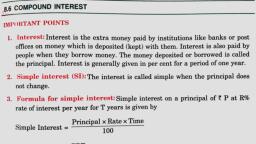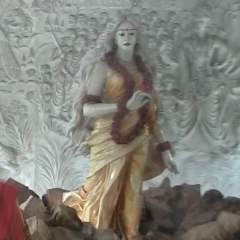Question 1 :
Let φ (x , y) = 0 be the equation of a circle. If φ (0, λ) = 0 has equal roots λ= 2, 2 and <br>φ (λ, 0) = 0 has roots λ =<img style='object-fit:contain' src='https://storage.googleapis.com/teachmint/question_assets/JEE%20Main/5e748c7e2ca8b87fce150aa1' height='37' width='15' >, 5 then the centre of the circle is
Question 2 :
A variable chord is drawn through the origin to the circle x<sup>2</sup> + y<sup>2 </sup>- 2ax = 0. The locus of the centre of the circle drawn on this chord as diameter is
Question 3 :
For hyperbola <img style='object-fit:contain' src='https://storage.googleapis.com/teachmint/question_assets/JEE%20Main/5e749c08f511820358e67ea1' height='47' width='123' > which of the following remains constant with change in 'α':
Question 4 :
For two triangles of area <img style='object-fit:contain' src='https://storage.googleapis.com/teachmint/question_assets/JEE%20Main/5e748c45f511820358e6776d' height='39' width='24' >are drawn inside a circle of radius 1, select the correct alternatives-
Question 5 :
If f (x) = <img style='object-fit:contain' src='https://storage.googleapis.com/teachmint/question_assets/JEE%20Main/5e749c252ca8b87fce1511c8' height='36' width='31' > and α, β (α >β) be the values of x, where f (f(x)) is not defined, then a ray of light parallel to the axis of the parabola Y<sup>2</sup> = 4x after reflection from the internal surface of the parabola will necessarily pass through the point.
Question 6 :
Axis of the parabola x<sup>2</sup> - 3y - 6x + 6 = 0 is
Question 7 :
The polars at (1, 7), (4, 8) w.r.t. y<sup>2</sup> = 4x meet at C. Then the equation of the polar of C w.r.t. the parabola is
Question 8 :
Given the circles x<sup>2</sup> + y<sup>2</sup> - 4x - 5 = 0 and x<sup>2</sup> + y<sup>2</sup> + 6x - 2y + 6 = 0. Let P be a point (α, β) such that the tangents from P to both the circles are equal. Then -
Question 9 :
If 3x<sup>2</sup> + 2λxy + 3y<sup>2</sup> + (6 - λ)x + (2λ - 6)y - 21 = 0 is the equation of a circle, then its radius is-
Question 10 :
Equation of hyperbola passing through origin and whose asymptotes are 3x + 4y = 5 and 4x + 3y = 5, is-
Question 11 :
P is a variable point on the parabola x<sup>2</sup> + 44x = y + 88 and Q is a point on the plane not lying on the parabola. If PQ<sup>2</sup> is minimum, then the angle between the tangent at P and PQ is-
Question 12 :
If O is the origin and OP, OQ are distinct tangents to the circle x<sup>2</sup> + y<sup>2</sup> + 2gx + 2fy + c = 0 then circumcentre of the triangle OPQ is
Question 13 :
The line y = 2t<sup>2</sup> meets the ellipse <img style='object-fit:contain' src='https://storage.googleapis.com/teachmint/question_assets/JEE%20Main/5e7499c8f511820358e67c13' height='43' width='79' > in real points if
Question 14 :
The ordinates of the triangle inscribed in parabola {tex} y ^ { 2 } = 4 a x {/tex} are {tex} y _ { 1 } , y _ { 2 } {/tex} and {tex} y _ { 3 } . {/tex} Then the area of the triangle is
Question 15 :
The normals drawn at three points to a parabola y<sup>2</sup> = 8x are concurrent at (3,4). Then the product of the ordinates of the points is
Question 16 :
The coordinates of the middle point of the chord {tex} 2 x - 5 y + 18 = 0 {/tex} cut off by the circle {tex} x ^ { 2 } + y ^ { 2 } - 6 x + 2 y - 54 = 0 {/tex} is
Question 17 :
Equation of circle touching lines | x - 1| + |y + 2| = 2 is
Question 18 :
The equation of a line passing through the centre of a rectangular hyperbola is x - y - 1 = 0. If one of its asymptotes is 3x - 4y - 6 = 0, the equation of the other asymptote is
Question 19 :
The vertex of the parabola {tex} x ^ { 2 } + 4 x + 2 y - 7 = 0 {/tex} is
Question 20 :
If {tex} y _ { 1 } {/tex} and {tex} y _ { 2 } {/tex} are the ordinates of two points {tex} P {/tex} and {tex} Q {/tex} on the parabola and {tex} y _ { 3 } {/tex} is the ordinate of the point of intersection of tangents at {tex} P {/tex} and {tex} Q {/tex} , then
Question 21 :
If the straight line y = mx is outside the circle <br>x<sup>2</sup> + y<sup>2</sup> -20y + 90 = 0, then
Question 22 :
If the coordinate at one end of diameter of the circle:
<b>x<sup>2</sup> + y<sup>2</sup> - 8x - 4y + c = 0</b> are <b>(-3,2)</b>, the coordinate at the other end are
Question 23 :
Consider the set of hyperbola xy = k, k ∈ R. Let e<sub>1</sub> and e<sub>2</sub> be <br>the eccentricities when k = 16 and k = 25 respectively then the value of e<sub>1</sub><sup>2 </sup>- e<sub>2</sub><sup>2</sup> equals-
Question 24 :
A parabola is drawn with its focus (3, 4) and vertex at the focus of the parabola y<sup>2</sup> - 12 x - 4y + 4 = 0. The equation of the parabola is -
Question 25 :
The length of the common chord of the ellipse <br><img style='object-fit:contain' src='https://storage.googleapis.com/teachmint/question_assets/JEE%20Main/5e749bbc46f7eb01d9e6d784' height='43' width='140' > and the circle (x - 1)<sup>2</sup> + (y - 2)<sup>2</sup> = 1:
Question 26 :
Tangents are drawn from the point P(-1, 6) to the circle x<sup>2</sup> + y<sup>2</sup> - 4x - 6y + 4 = 0. If A and B are the points of contact of these tangents and 'O' be the centre of the circle, then area of quadrilateral PAOB is-
Question 27 :
If x = 9 is the chord of contact of the hyperbola x<sup>2</sup> - y<sup>2</sup> = 9, then the equation of the corresponding pair of tangents is -
Question 28 :
The equation of the tangents drawn at the ends of the major axis of the ellipse 9x<sup>2</sup> + 5y<sup>2</sup> - 30y = 0, are-
Question 29 :
If the straight line x+y = k touches the parabola y = x-x<sup>2</sup>, then k =
Question 30 :
Number of normal that can be drawn from point of intersection of x-axis & line 2007x + 2008y - 2009 = 0 to circle x<sup>2</sup> + y<sup>2</sup> = 2009
Question 31 :
If the line lx + my + n = 0 meets the hyperbola <img style='object-fit:contain' src='https://storage.googleapis.com/teachmint/question_assets/JEE%20Main/5e749ab346f7eb01d9e6d655' height='41' width='52' > = 1 at the extremities of a pair of conjugate diameters, then the relation a<sup>2</sup> - b<sup>2</sup>m<sup>2</sup> is equal to -
Question 32 :
A rectangular hyperbola whose centre is C is cut by any circle of radius r in four points P, Q, R and S. Then CP<sup>2</sup> + CQ<sup>2</sup> + CR<sup>2</sup> + CS<sup>2</sup> is equal to
Question 33 :
The length of the chord cut off by {tex} y = 2 x + 1 {/tex} from the circle {tex} x ^ { 2 } + y ^ { 2 } = 2 {/tex} is
Question 34 :
If 4 - 5m<sup>2</sup> + 6l + 1 = 0, then the line lx + my + 1 = 0 touches a fixed circle. Then the equation of circle is -
Question 35 :
If the tangent at the point (4 cos φ , (16/√11) sin φ) to the ellipse 16x<sup>2</sup> + 11y<sup>2</sup> = 256 is also a tangent to the circle x<sup>2</sup> + y<sup>2</sup> - 2x = 15, then the value of φ is-
Question 36 :
The abscissa of A and B are the roots of the equation x<sup>2</sup> + 2ax - b<sup>2</sup> = 0 and their ordinates are the roots of the equation y<sup>2</sup> + 2py - q<sup>2</sup> = 0. The equation of the circle with AB as diameter:
Question 37 :
The line 3x + 2y + 1 = 0 meets the hyperbola 4x<sup>2</sup> - y<sup>2</sup> = 4a<sup>2</sup> in the points P and Q. The coordinates of the point of intersection of the tangents at P and Q are
Question 38 :
Let {tex} A B {/tex} be a chord of the circle {tex} x ^ { 2 } + y ^ { 2 } = r ^ { 2 } {/tex} subtending a right angle at the centre. Then the centroid of the triangle {tex} PAB {/tex} as {tex} P {/tex} moves on the circle is
Question 39 :
If the tangent to the ellipse x<sup>2</sup> + 4y<sup>2</sup> = 16 at the point P(θ) is a normal to the circle x<sup>2</sup> + y<sup>2</sup> - 8x - 4y = 0, then θ equals
Question 40 :
The point diametrically opposite to the point {tex} P ( 1,0 ) {/tex} on the circle {tex} x ^ { 2 } + y ^ { 2 } + 2 x + 4 y - 3 = 0 {/tex} is
Question 41 :
If from any point on the circle {tex} x ^ { 2 } + y ^ { 2 } = a ^ { 2 } {/tex} tangents are drawn to the circle {tex} x ^ { 2 } + y ^ { 2 } = a ^ { 2 } \sin ^ { 2 } \alpha , {/tex} then the angle between the tangents, is
Question 42 :
For what value of {tex} c {/tex} will the line {tex} y = 2 x + c {/tex} be a tangent to the circle {tex} x ^ { 2 } + y ^ { 2 } = 5 ? {/tex}
Question 43 :
The value of {tex} k {/tex} for which two tangents can be drawn from {tex} ( k , k ) {/tex} to the circle {tex} x ^ { 2 } + y ^ { 2 } + 2 x + 2 y - 16 = 0 {/tex} is
Question 44 :
The two circles {tex} x ^ { 2 } + y ^ { 2 } = a x {/tex} and {tex} x ^ { 2 } + y ^ { 2 } = c ^ { 2 } ( c > 0 ) {/tex} touch each other if
Question 45 :
The tangent at the point A(12, 6) to a parabola intersects its directrix at the point B(-1, 2). The focus of the parabola lies on x-axis. The number of such parabolas is-
Question 46 :
The number of points with integral coordinates that lie in the interior of the region common to the circle x<sup>2</sup> + y<sup>2</sup> = 16 and the parabola y<sup>2</sup> = 4x is -
Question 47 :
A chord is drawn through the focus of the parabola {tex} y ^ { 2 } = 6 x {/tex} such that its distance from the vertex of this parabola is {tex} \frac { \sqrt { 5 } } { 2 } {/tex} , then its slope can be
Question 48 :
The point on the curve y<sup>2</sup> = 4x which is nearest to (2, 1) is
Question 49 :
AB is a chord of the parabola y<sup>2</sup> = 4ax with vertex at A. BC is drawn perpendicular to AB meeting the axis at C. The projection of BC on the x-axis is-
Question 50 :
The coordinates of the point on the circle {tex} x ^ { 2 } + y ^ { 2 } - 12 x - 4 y + 30 {/tex} {tex} = 0 {/tex} which is farthest from the origin are
Question 51 :
The circle on focal radii of a parabola as diameter touches the
Question 52 :
If a bar of given length moves with its extremities on two fixed straight lines at right angles, then the locus of any point on bar marked on the bar describes a/an
Question 53 :
AB, AC are tangents to a parabola y<sup>2</sup> = 4ax; p<sub>1</sub>, p<sub>2</sub>, p<sub>3</sub> are the lengths of the perpendiculars from A, B, C on any tangent to the curve, then p<sub>2</sub>, p<sub>1</sub>, p<sub>3</sub> are in
Question 54 :
<font>If the tangent at the point P on the circle x</font><sup><font>2</font></sup><font> + y</font><sup><font>2</font></sup><font> + 6x + 6y = 2 meets the straight line 5x - 2y + 6 = 0 at a point Q on the y-axis, then the length of PQ is</font></p>
Question 55 :
The two parabolas y<sup>2</sup> = 4x and x<sup>2</sup> = 4 y intersect at a point P, whose abscissae is not zero, such that
Question 56 :
<font>A rectangular hyperbola whose centre is C is cut by any circle of radius r in four points P, Q, R and S. Then CP</font><sup><font>2</font></sup><font> + CQ</font><sup><font>2</font></sup><font> + CR</font><sup><font>2</font></sup><font> + CS</font><sup><font>2</font></sup><font> is equal to</font></p>
Question 57 :
A tangent to the ellipse x<sup>2</sup> + 4y<sup>2</sup> = 4 meets the ellipse x<sup>2</sup> + 2y<sup>2</sup> = 6 at P and Q. The angle between the tangent at P and Q of the ellipse x<sup>2</sup> + 2y<sup>2</sup> = 6 is
Question 58 :
Let C be the centre of the ellipse $\frac{x^{2}}{a^{2}} + \frac{y^{2}}{b^{2}} = 1.$ If the tangent at any point on the ellipse cuts the coordinate axes in P and Q respectively, then $\frac{a^{2}}{CP^{2}} + \frac{b^{2}}{CQ^{2}} =$
Question 59 :
The straight line y = mx + c cuts the circle x<sup>2</sup> + y<sup>2</sup> = a<sup>2</sup> in real points if
Question 60 :
If P<sub>1</sub>, P<sub>2</sub>, P<sub>3</sub> are the perimeter of the three circles x<sup>2</sup> + y<sup>2</sup> + 8x − 6y = 0, 4x<sup>2</sup> + 4y<sup>2</sup> − 4x − 12y − 186 = 0 and x<sup>2</sup> + y<sup>2</sup> − 6x + 6y − 9 = 0 respectively, then
Question 61 :
Two perpendicular tangents to y<sup>2</sup> = 4ax always intersect on the line, if
Question 62 :
Equation of the chord of the hyperbola 25x<sup>2</sup> − 16y<sup>2</sup> = 400 which is bisected at the point (6, 2), is
Question 63 :
The foci of the ellipse $\frac{x^{2}}{16} + \frac{y^{2}}{b^{2}} = 1$ and the hyperbola $\frac{x^{2}}{144} - \frac{y^{2}}{81} = \frac{1}{25}$ coincide. Then, the value of b<sup>2</sup> is
Question 64 :
The sum of the distances of a point (2, − 3) from the foci of an ellipse 16 (x−2)<sup>2</sup>+ 25 (y+3)<sup>2</sup> = 400 is
Question 65 :
If a circle passes through the point (1, 2) and cuts the circle x<sup>2</sup> + y<sup>2</sup> = 4 orthogonally, then the equation of the locus of its centre is













































